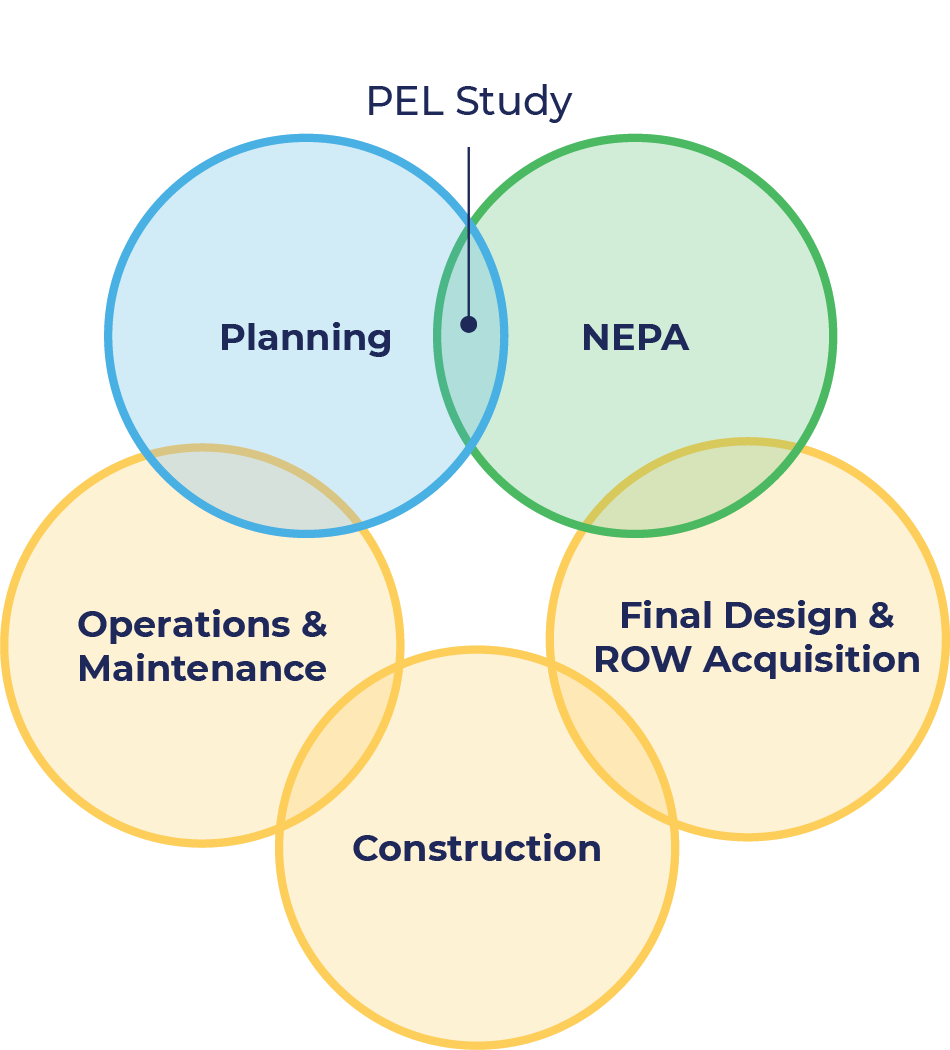PennDOT Pathways: Planning & Environmental Linkages Virtual Public Meeting
This page is best viewed in Chrome, Edge or Firefox.
PennDOT Pathways Virtual Public Meeting
Thank you for joining us to learn more about the PennDOT Pathways PEL Study and provide your input.
To respect your health and adhere to public safety and social distancing guidelines, we are presenting information on the study through an on-demand virtual public meeting. You can access this meeting and submit your comments at your convenience.
How to Navigate This Meeting
To advance to the next portion of the meeting, scroll down or use the navigation bar at the top of the page to revisit any part of the meeting.
What is a PEL Study?
A Planning and Environmental Linkages (PEL) study integrates the planning and environmental phases of a program or project's development. By integrating environmental analysis steps during planning, the results can be incorporated into subsequent environmental documents prepared in accordance with the National Environmental Policy Act (NEPA) without repeating those steps; thereby promoting efficiency and potentially accelerating project delivery.

PennDOT Pathways and the PEL Study
The purpose of the PennDOT Pathways PEL Study is to identify the best near- and long-term options to fill our growing transportation funding gap. By introducing additional funding strategies, we can provide adequate revenue for maintaining the Commonwealth's highways and bridges in a state of good repair. The PEL Study helps establish this path forward.
Use the top navigation bar to learn more about the PEL findings or click the button below to view a PDF copy of the draft PEL Study.
PEL Study Findings
PEL Study Structure
The PEL Study is broken down into the following sections which cover:
- Background about the transportation funding gap
- Discussion of alternative funding options and which might be candidates for near-term versus long-term solutions
- Identification of methodology for addressing environmental effects of the solutions including effects on low-income and minority populations
- Public and agency outreach conducted as part of the PEL study
Potential Near-Term Solutions
What:
This solution would involve tolling major bridge replacement or extensive rehabilitation projects as a means of funding these expensive projects. By major bridges, we mean structures that are costly to replace and/or have the potential for substantial disruption to traffic patterns due to closures or restrictions. Tolls collected would be used for funding replacement or rehabilitation, and maintenance of the bridges.
When:
Could be advanced in the next 2-4 years
Why:
Drivers that use the bridge pay for the bridge, including out-of-state travelers. Authority exists through 23 USC 129 for states to toll bridges as a means of paying for replacement or rehabilitation. Pennsylvania state law requires that tolling use a public-private partnership and received the Pennsylvania P3 Board's approval — which was received in November 2020. Because additional legal or legislative action is not required, this option can be implemented more quickly than many other alternative funding options. With 137 toll bridges in the country, tolling is a proven means of funding major transportation projects.
Where & How:
Bridge tolling can be a feasible option through the Major Bridge P3 Initiative. Nine candidate bridge projects have been identified and were announced in February 2021.
Requires and has P3 Board Approval
What:
Managed lanes are lanes added to a highway where traffic is regulated by charging a toll to use the new lanes, or by encouraging carpooling — high occupancy vehicles (HOVs) typically can use the new lanes free of charge. This option offers a choice to drivers — to pay a fee to use the new managed lanes, carpool and use the new lanes for free, or use the existing regular free lanes.
When:
Could potentially be advanced in 2-4 years
Why:
Drivers using managed lanes typically receive consistent, reliable travel times. The added capacity of the managed lanes can also result in better flow in the regular free lanes.
Where & How:
Managed lanes work best in corridors with recurring peak-period congestion. In selecting managed lane candidates PennDOT would consider factors such as the connectivity of the network, congestion levels and travel time.
Requires P3 Board Approval
Potential Medium- to Long-Term Solutions
What:
Congestion pricing is a form of tolling where all users driving in a specific zone are charged variable fees based on how many cars are on the roadway — higher fees during more congested time periods. Unlike managed lanes, no new lanes are added. Drivers are incentivized to carpool, alter the time of their travel, use transit, or use other routes when traffic gets too heavy.
When:
Could potentially be advanced in 4-6 years
Why:
Congestion pricing can lead to less congested urban centers, meaning better air quality and more reliable travel times.
Where & How:
Congestion pricing would be considered in urban areas where roadway congestion is a consistent problem, and would require acceptance into the Value Pricing Pilot Program (VPPP), a federal pilot program, for implementation.
Requires P3 Board Approval
What:
This involves tolling interstates and expressways based on the distance traveled along that road. All lanes in the corridor are tolled. The existing Pennsylvania Turnpike is an example of corridor tolling.
When:
Would require 6+ years to advance
Why:
With corridor tolling, only those that use the interstate or expressway pay for it, including out-of-state travelers.
Where & How:
Corridor tolling would be considered on interstates and expressways only and could be implemented by leveraging existing tolling technology and infrastructure. The tolling of expressways for the reconstruction or rehabilitation of a roadway would require approval by Pennsylvania's P3 Board. Interstate tolling would also require P3 approval as well as acceptance into the federal Interstate System Reconstruction and Rehabilitation Pilot Program (ISRRPP).
Requires P3 Board Approval
What:
Mileage-Based User Fees (MBUFs) are a little different from tolls in that they are usually tied to odometer readings or other distance-based technologies to determine the number of miles you drive. Drivers are charged a small fee for each mile they drive during a set timeframe.
When:
Would take 6+ years to advance
Why:
This approach has been studied in multiple states as a viable and equitable way to replace the gas tax. Drivers pay for the miles they drive regardless of whether their vehicle is electric, hybrid or gas-powered.
Where & How:
MBUFs would require establishing a new statewide program and enabling legislation which is not currently in place.
What:
This option could include increasing vehicle licensing fees, registration fees, or the sales tax.
When:
Would take 6+ years to advance
Why:
There are a number of potential items that, with increased fees or taxes, could effectively address the transportation funding gap.
Where & How:
Many of the fee or tax changes studied would require changes to the tax code and passing of state legislation to implement. The legislation would provide direction on what the additional sales taxes or fees can be used for and how the revenue would be distributed.
Closing the Gap
What Questions Did We Evaluate?
Evaluating Funding Options
Each potential funding option comes with its own opportunities and challenges. We evaluated the following factors when assessing each potential funding option:
- To what degree can this option fill the funding gap?
- What authority or approvals would be needed for implementation?
- How long would it take to implement?
- How might this option affect the traveling public, low-income and minority populations, as well as various stakeholder organizations?
PennDOT evaluated these various factors and identified the most promising options which could be implemented in the near-term, versus those which would require longer term coordination.
Public Involvement
We heard from thousands of Pennsylvanians while conducting the PEL Study and your feedback helped shape the results.
4,000+
initial public survey responses
4,000+
Public Comments
via email, telephone hotline, or web form
2 Equity in Transportation Working Group Sessions
with Community Organizations & MPOs
300+
environmental justice survey responses

111,000+
website visits

4,000+
initial public survey responses

4,000+
Public Comments
via email, telephone hotline, or web form

2
Equity in Transportation Working Group Sessions
with Community Organizations & MPOs

300+
environmental justice survey responses
Funding Option Implementation
Implementation Process*
How would any of these funding options actually be implemented?
1
Project Identification
The first step would be to identify the specific project(s) that will utilize the funding option. For example, a specific expressway where capacity would be added and funded through the addition of managed lanes.
2
Environmental Review
The project would undergo its own environmental review process under NEPA. Through this review process, potential impacts to surrounding natural, community, and cultural resources would be analyzed.
3
Public Input
Multiple opportunities for public input would be provided throughout the environmental review process.
* Consistent with federal and state requirements, including P3 Board approval (go back)
Equity Analysis
For those funding options involving tolling, each specific project would go through an environmental review process and decision-making process to assess the potential effect of the tolling strategy on minority and low-income populations. These potential effects could include:
- Diversion Impacts: Various effects can occur on local communities from vehicles avoiding the toll by using alternative routes. The extra traffic on diversion routes may result in congestion on these routes if they do not possess sufficient capacity to handle the added traffic.
- Financial Impacts: The financial impact of paying a toll or managing a toll payment account can create burdens, particularly for low-income populations.
If disproportionate effects on minority or low-income populations are determined through a project's environmental review process, potential measures to lessen the impact will also be studied.
Next Steps For the PEL